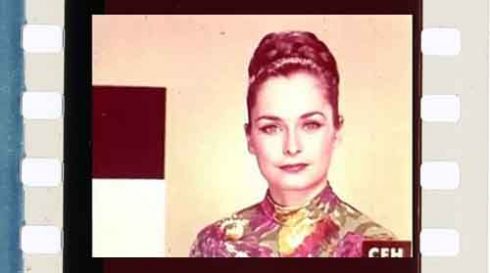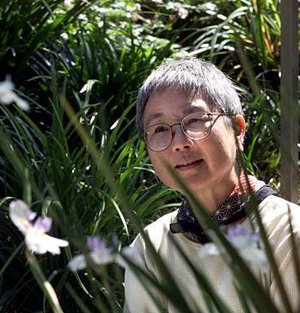“China Girls”
By Katherine Hisako Glascock
[Katherine Hisako Fukami Glascock (August 31, 1940-October 15, 2017) was a musician, artist, and was best known as a landscape designer. She was married to Baylis Glascock, who we have featured previously on this website, for more than 50 years. In a May 22, 2003, article on her work in the Los Angeles Times, the paper’s garden specialist Emily Green wrote:
[“Katherine Glascock creates gardens that express the true nature of the land and the people who live there. No two are alike, but all bring together strength and elegance.”
[Baylis has made available to us two samples of Katherine’s writing. The first, “Finding Bambi,” written in the late 1990s, we featured in our October 1, 2018, postings. This month we are publishing her essay “China Girls,” written on May 15, 2013.]
* * *
The following is from the program notes of a Los Angeles Filmforum presentation, titled “China Girls”, May 12, 2013, Spielberg Theatre at the Egyptian.
“The various faces of the ‘China girl’, sometimes called a ‘China doll’ or ‘girl head’, have appeared in more films than any actress, though she is almost never seen, save for the fleeting glimpses an audience might catch at the end of a film reel. These images of a woman, positioned next to color swatches, have appeared on the leader of every commercial manufactured film since the late 1920s and continue in limited use today. The China girl image is instrumental in determining exposure, image density, and color balance, forming a kind of cinematic unconscious. Her essential but often overlooked role in film history has also made her a compelling subject for experimental filmmakers variously examining issues of celluloid materiality, the behind-the-scenes workings of the film industry, and the often marginal role of women. In some cases, the China girl is no less than the enigmatic icon of a vanishing medium.”
–Genevieve Yue
As in a conference of archeologists the comments focused on dates, locations and circumstances surrounding the finding and salvaging of each piece of leader with a China girl. Then followed six experimental films using the now scarce and precious bits of film, each about two or three frames in length. In viewing the films, we saw the China girls in compilations recalling their context: blank leader, messages to the projectionist, more blank leader with marks and smudges, edge lettering and numbers, dirt particles, and countdown graphics. All of which are documents, much as the wear patterns of a jacket or shoes tell us of their journeys.
Later open discussion covered details about the film industry practices of each era, the evolution in materials and technology and processes of handling and viewing and measuring standards; and the inevitable: social reality. For example, that women played a minor and mainly supportive role, except in front of the camera. That, in most of the examples shown, the faces were of unknown women. Their faces were merely standing in as references for skin tone for people in the film proper. This was followed, as would be expected, with discussions of skin color and race, and the history of depicting persons of ethnicity other than white. How China came to be linked with her image is not definitively known, although during the 50s and 60s she is wearing a multi-color print dress with a Mandarin collar.
I left the event with the impression of having encountered a beautiful and precious find, reaching back in time, predating by eons the world of cinema, connecting with imagery of the ages. Perhaps this comes now because of my regular exposure to our twin grandchildren at play. Their play is as intense and deep as work by anyone else, perhaps more so. They begin, often each doing something apart from the other, but in deep concentration with subject matter known usually only to the player with absolute quiet, some murmured dialogue, moving of things, objects, with an occasional pronouncement at large. Then something, some idea, may cross over and they join together, taking turns directing the new events. But some deep personal connection has been worked on, meaningfully expressed, for each child, and perhaps shared in the interaction if that should be the case.
The few frames of China girl tucked into the working ends of film speak to me of some deep delving. Here they came to a spot waiting to be made into a key, a signifier, the opener, the rule-maker for the game. To be seen only by the few chosen players for the good of the final product. Thus, the moment for that precious placeholder from his deepest heart: Mother, his first love, most giving of all good things, reference point of all things important, beautiful and desirable. Being of all his desires. She the Queen of Hearts shall be represented by the beautiful village girl. This girl shall be raised beyond her own knowing to iconic perfection. And she will be in a vehicle bearing the base elementals: top row, the holy trinity of the gray scale, and below, the palette of earthly color, red, blue, green, yellow, cyan, and magenta. Surrounded by the designated canon and scales she is far more than herself.
The anonymous woman figure has been with us throughout human history. At a time when its power was being tested, the Roman Catholic Church reached into the depths of the pre-Christian nature-centered practices of the people and found Her and made her into its own feminine icon: the Virgin Mary holding the universal sphere in one hand, her foot on the head of the serpent, and cradling the Infant on her lap. In her few frames the China girl is the Muse of Cinema, saying,
Pay attention here, we are at a junction in the road; mind your steps.
In her times the China girl has served in her role as the silent protectress of the magic-making heart of cinema.
Comments
Leave a Reply
You must be logged in to post a comment.






